Projects Negotiation and Conflict Report for Queensland Health Payroll Program
VerifiedAdded on 2023/06/09
|7
|2494
|376
AI Summary
This report discusses the negotiation and conflict management strategies for the Queensland Health Payroll Program. It covers the project characteristics, participants, negotiation interaction process, negotiation methods, and outcomes.
Contribute Materials
Your contribution can guide someone’s learning journey. Share your
documents today.
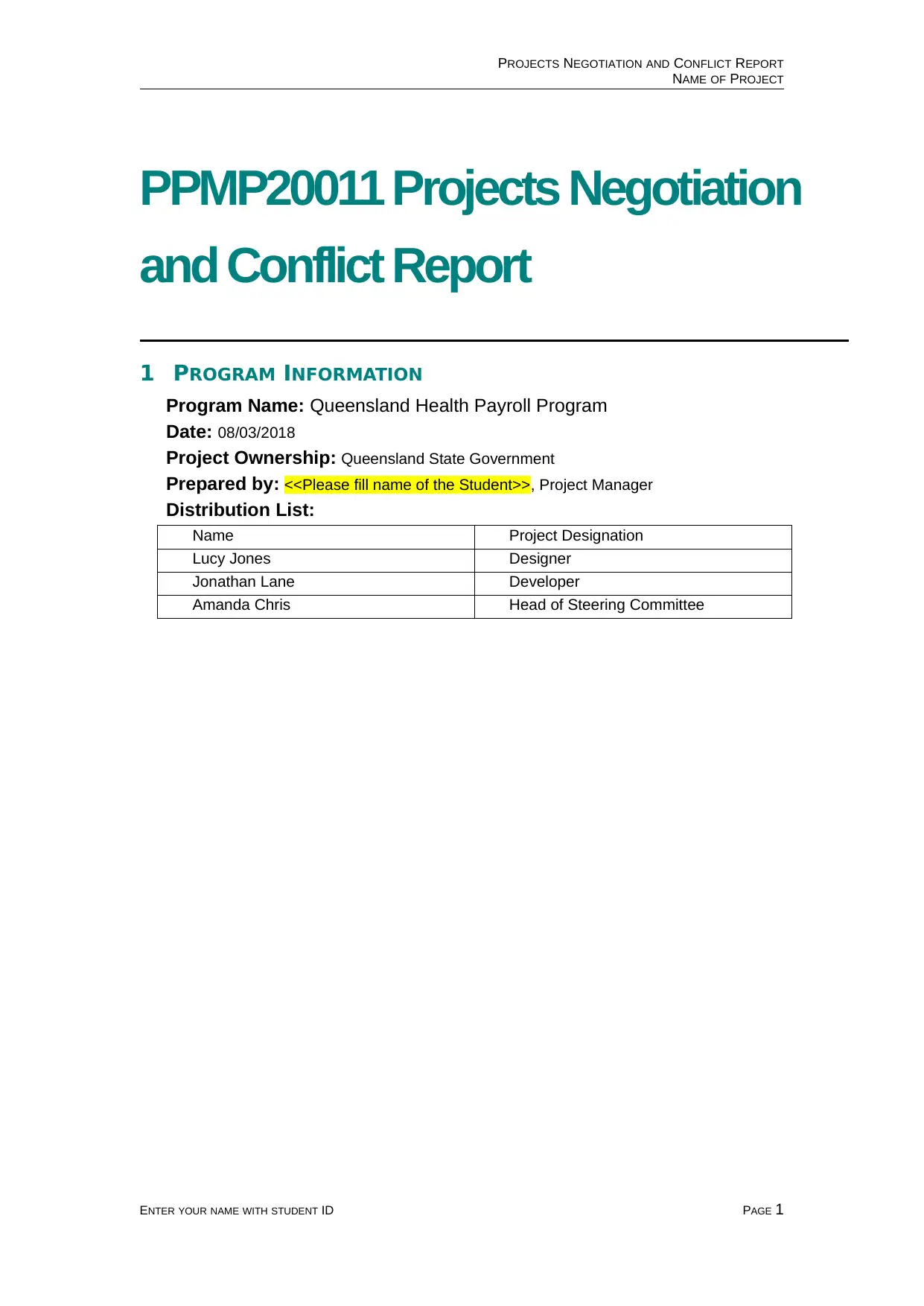
PROJECTS NEGOTIATION AND CONFLICT REPORT
NAME OF PROJECT
PPMP20011 Projects Negotiation
and Conflict Report
1 PROGRAM INFORMATION
Program Name: Queensland Health Payroll Program
Date: 08/03/2018
Project Ownership: Queensland State Government
Prepared by: <<Please fill name of the Student>>, Project Manager
Distribution List:
Name Project Designation
Lucy Jones Designer
Jonathan Lane Developer
Amanda Chris Head of Steering Committee
ENTER YOUR NAME WITH STUDENT ID PAGE 1
NAME OF PROJECT
PPMP20011 Projects Negotiation
and Conflict Report
1 PROGRAM INFORMATION
Program Name: Queensland Health Payroll Program
Date: 08/03/2018
Project Ownership: Queensland State Government
Prepared by: <<Please fill name of the Student>>, Project Manager
Distribution List:
Name Project Designation
Lucy Jones Designer
Jonathan Lane Developer
Amanda Chris Head of Steering Committee
ENTER YOUR NAME WITH STUDENT ID PAGE 1
Secure Best Marks with AI Grader
Need help grading? Try our AI Grader for instant feedback on your assignments.
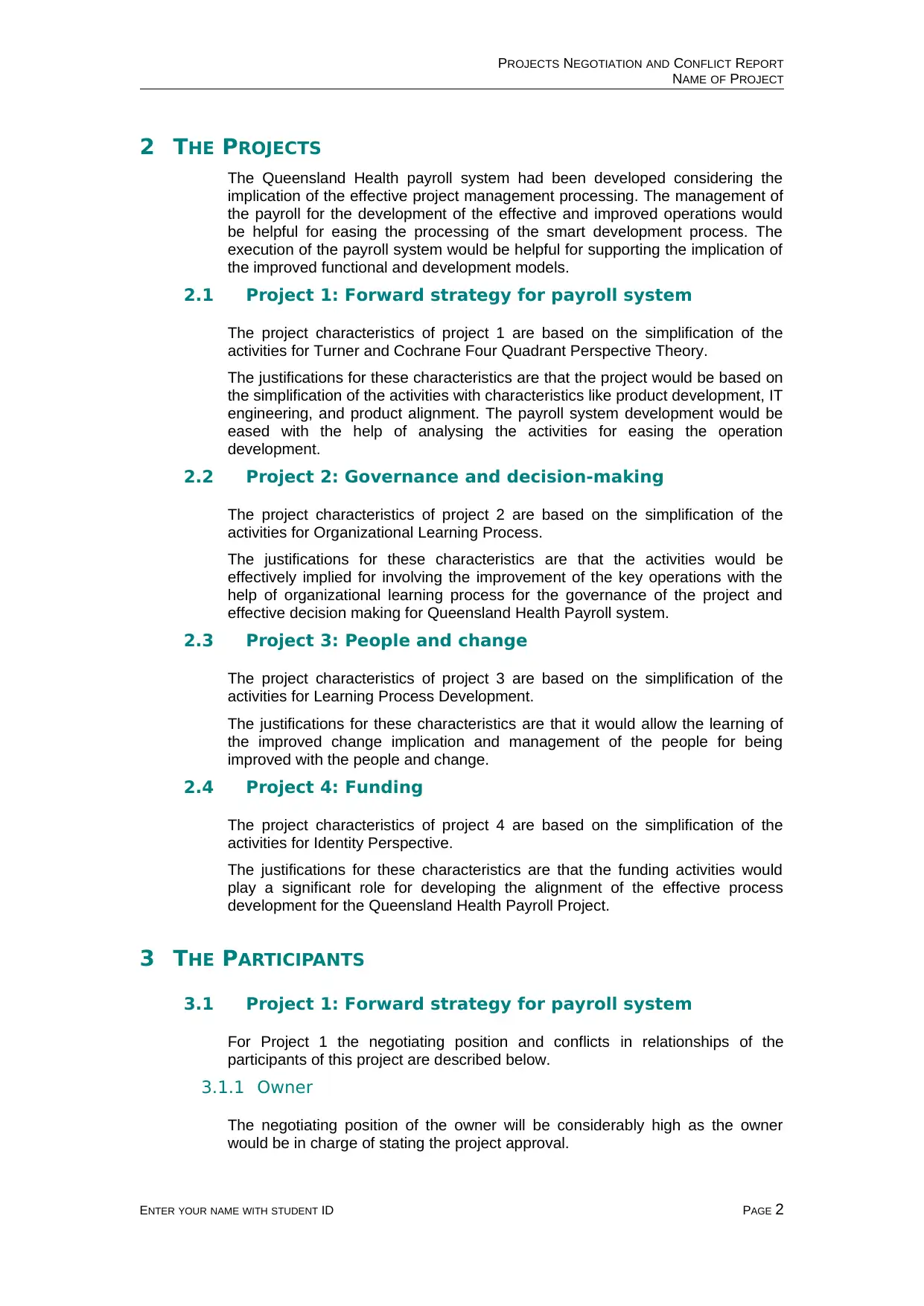
PROJECTS NEGOTIATION AND CONFLICT REPORT
NAME OF PROJECT
2 THE PROJECTS
The Queensland Health payroll system had been developed considering the
implication of the effective project management processing. The management of
the payroll for the development of the effective and improved operations would
be helpful for easing the processing of the smart development process. The
execution of the payroll system would be helpful for supporting the implication of
the improved functional and development models.
2.1 Project 1: Forward strategy for payroll system
The project characteristics of project 1 are based on the simplification of the
activities for Turner and Cochrane Four Quadrant Perspective Theory.
The justifications for these characteristics are that the project would be based on
the simplification of the activities with characteristics like product development, IT
engineering, and product alignment. The payroll system development would be
eased with the help of analysing the activities for easing the operation
development.
2.2 Project 2: Governance and decision-making
The project characteristics of project 2 are based on the simplification of the
activities for Organizational Learning Process.
The justifications for these characteristics are that the activities would be
effectively implied for involving the improvement of the key operations with the
help of organizational learning process for the governance of the project and
effective decision making for Queensland Health Payroll system.
2.3 Project 3: People and change
The project characteristics of project 3 are based on the simplification of the
activities for Learning Process Development.
The justifications for these characteristics are that it would allow the learning of
the improved change implication and management of the people for being
improved with the people and change.
2.4 Project 4: Funding
The project characteristics of project 4 are based on the simplification of the
activities for Identity Perspective.
The justifications for these characteristics are that the funding activities would
play a significant role for developing the alignment of the effective process
development for the Queensland Health Payroll Project.
3 THE PARTICIPANTS
3.1 Project 1: Forward strategy for payroll system
For Project 1 the negotiating position and conflicts in relationships of the
participants of this project are described below.
3.1.1 Owner
The negotiating position of the owner will be considerably high as the owner
would be in charge of stating the project approval.
ENTER YOUR NAME WITH STUDENT ID PAGE 2
NAME OF PROJECT
2 THE PROJECTS
The Queensland Health payroll system had been developed considering the
implication of the effective project management processing. The management of
the payroll for the development of the effective and improved operations would
be helpful for easing the processing of the smart development process. The
execution of the payroll system would be helpful for supporting the implication of
the improved functional and development models.
2.1 Project 1: Forward strategy for payroll system
The project characteristics of project 1 are based on the simplification of the
activities for Turner and Cochrane Four Quadrant Perspective Theory.
The justifications for these characteristics are that the project would be based on
the simplification of the activities with characteristics like product development, IT
engineering, and product alignment. The payroll system development would be
eased with the help of analysing the activities for easing the operation
development.
2.2 Project 2: Governance and decision-making
The project characteristics of project 2 are based on the simplification of the
activities for Organizational Learning Process.
The justifications for these characteristics are that the activities would be
effectively implied for involving the improvement of the key operations with the
help of organizational learning process for the governance of the project and
effective decision making for Queensland Health Payroll system.
2.3 Project 3: People and change
The project characteristics of project 3 are based on the simplification of the
activities for Learning Process Development.
The justifications for these characteristics are that it would allow the learning of
the improved change implication and management of the people for being
improved with the people and change.
2.4 Project 4: Funding
The project characteristics of project 4 are based on the simplification of the
activities for Identity Perspective.
The justifications for these characteristics are that the funding activities would
play a significant role for developing the alignment of the effective process
development for the Queensland Health Payroll Project.
3 THE PARTICIPANTS
3.1 Project 1: Forward strategy for payroll system
For Project 1 the negotiating position and conflicts in relationships of the
participants of this project are described below.
3.1.1 Owner
The negotiating position of the owner will be considerably high as the owner
would be in charge of stating the project approval.
ENTER YOUR NAME WITH STUDENT ID PAGE 2
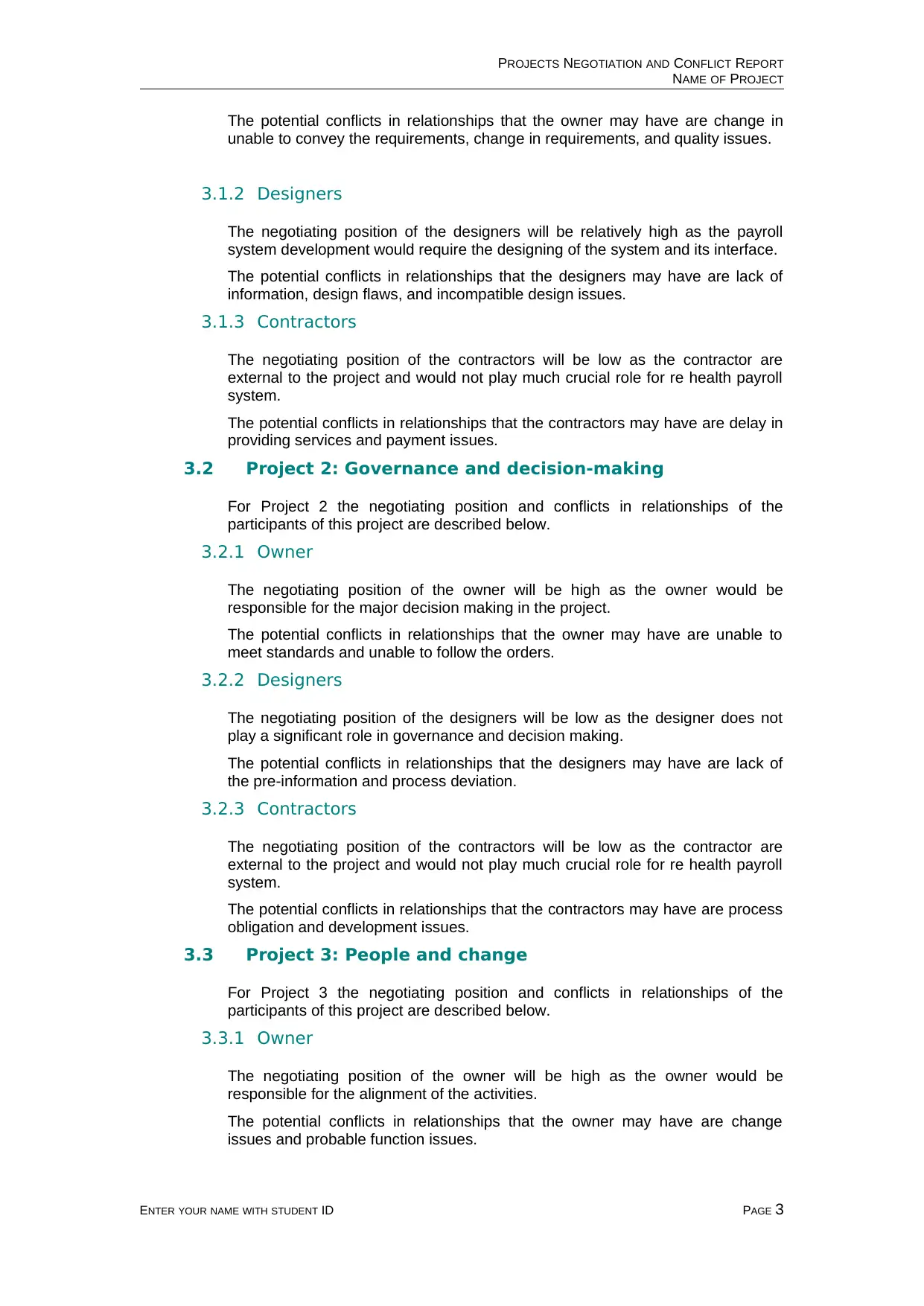
PROJECTS NEGOTIATION AND CONFLICT REPORT
NAME OF PROJECT
The potential conflicts in relationships that the owner may have are change in
unable to convey the requirements, change in requirements, and quality issues.
3.1.2 Designers
The negotiating position of the designers will be relatively high as the payroll
system development would require the designing of the system and its interface.
The potential conflicts in relationships that the designers may have are lack of
information, design flaws, and incompatible design issues.
3.1.3 Contractors
The negotiating position of the contractors will be low as the contractor are
external to the project and would not play much crucial role for re health payroll
system.
The potential conflicts in relationships that the contractors may have are delay in
providing services and payment issues.
3.2 Project 2: Governance and decision-making
For Project 2 the negotiating position and conflicts in relationships of the
participants of this project are described below.
3.2.1 Owner
The negotiating position of the owner will be high as the owner would be
responsible for the major decision making in the project.
The potential conflicts in relationships that the owner may have are unable to
meet standards and unable to follow the orders.
3.2.2 Designers
The negotiating position of the designers will be low as the designer does not
play a significant role in governance and decision making.
The potential conflicts in relationships that the designers may have are lack of
the pre-information and process deviation.
3.2.3 Contractors
The negotiating position of the contractors will be low as the contractor are
external to the project and would not play much crucial role for re health payroll
system.
The potential conflicts in relationships that the contractors may have are process
obligation and development issues.
3.3 Project 3: People and change
For Project 3 the negotiating position and conflicts in relationships of the
participants of this project are described below.
3.3.1 Owner
The negotiating position of the owner will be high as the owner would be
responsible for the alignment of the activities.
The potential conflicts in relationships that the owner may have are change
issues and probable function issues.
ENTER YOUR NAME WITH STUDENT ID PAGE 3
NAME OF PROJECT
The potential conflicts in relationships that the owner may have are change in
unable to convey the requirements, change in requirements, and quality issues.
3.1.2 Designers
The negotiating position of the designers will be relatively high as the payroll
system development would require the designing of the system and its interface.
The potential conflicts in relationships that the designers may have are lack of
information, design flaws, and incompatible design issues.
3.1.3 Contractors
The negotiating position of the contractors will be low as the contractor are
external to the project and would not play much crucial role for re health payroll
system.
The potential conflicts in relationships that the contractors may have are delay in
providing services and payment issues.
3.2 Project 2: Governance and decision-making
For Project 2 the negotiating position and conflicts in relationships of the
participants of this project are described below.
3.2.1 Owner
The negotiating position of the owner will be high as the owner would be
responsible for the major decision making in the project.
The potential conflicts in relationships that the owner may have are unable to
meet standards and unable to follow the orders.
3.2.2 Designers
The negotiating position of the designers will be low as the designer does not
play a significant role in governance and decision making.
The potential conflicts in relationships that the designers may have are lack of
the pre-information and process deviation.
3.2.3 Contractors
The negotiating position of the contractors will be low as the contractor are
external to the project and would not play much crucial role for re health payroll
system.
The potential conflicts in relationships that the contractors may have are process
obligation and development issues.
3.3 Project 3: People and change
For Project 3 the negotiating position and conflicts in relationships of the
participants of this project are described below.
3.3.1 Owner
The negotiating position of the owner will be high as the owner would be
responsible for the alignment of the activities.
The potential conflicts in relationships that the owner may have are change
issues and probable function issues.
ENTER YOUR NAME WITH STUDENT ID PAGE 3
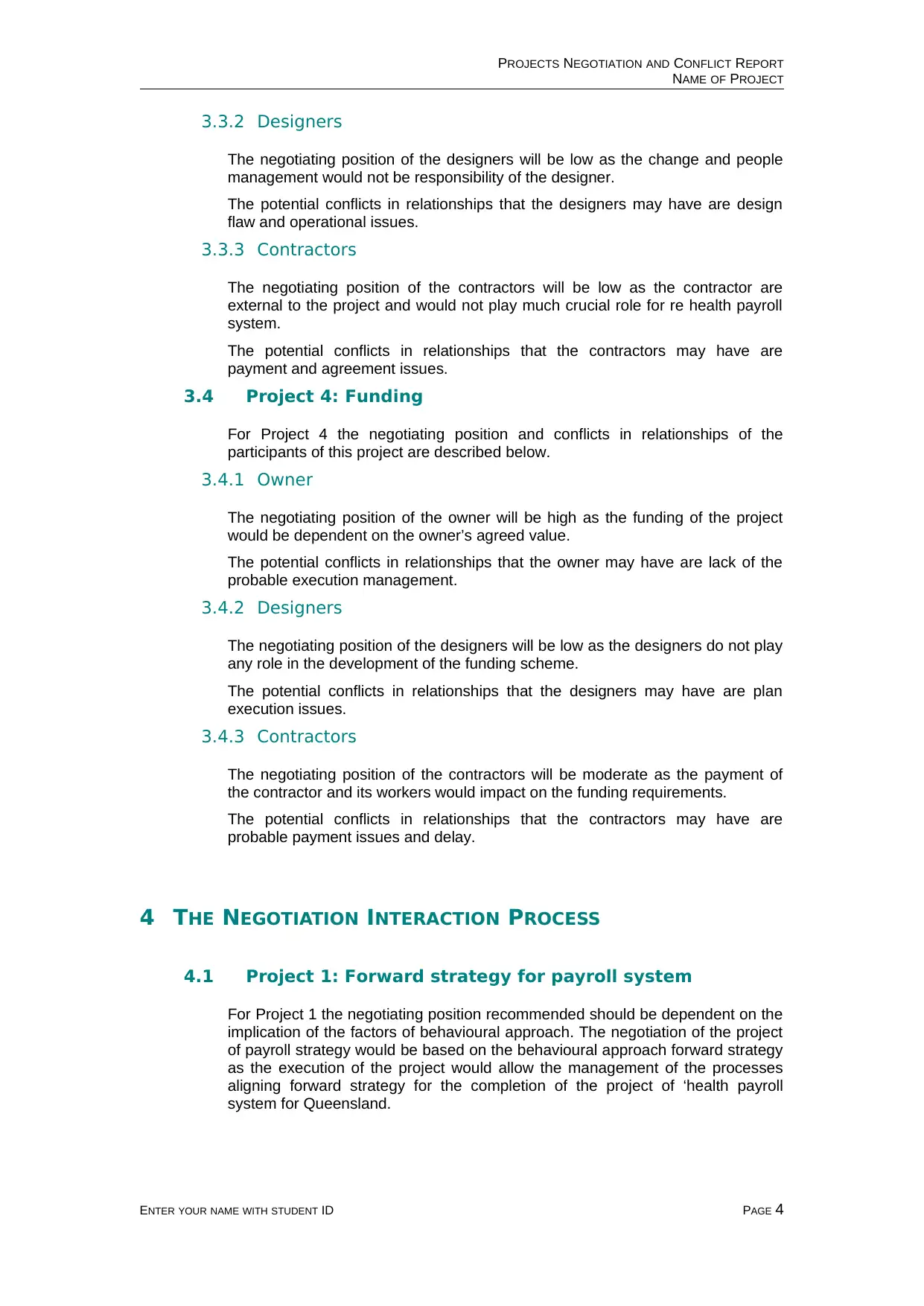
PROJECTS NEGOTIATION AND CONFLICT REPORT
NAME OF PROJECT
3.3.2 Designers
The negotiating position of the designers will be low as the change and people
management would not be responsibility of the designer.
The potential conflicts in relationships that the designers may have are design
flaw and operational issues.
3.3.3 Contractors
The negotiating position of the contractors will be low as the contractor are
external to the project and would not play much crucial role for re health payroll
system.
The potential conflicts in relationships that the contractors may have are
payment and agreement issues.
3.4 Project 4: Funding
For Project 4 the negotiating position and conflicts in relationships of the
participants of this project are described below.
3.4.1 Owner
The negotiating position of the owner will be high as the funding of the project
would be dependent on the owner’s agreed value.
The potential conflicts in relationships that the owner may have are lack of the
probable execution management.
3.4.2 Designers
The negotiating position of the designers will be low as the designers do not play
any role in the development of the funding scheme.
The potential conflicts in relationships that the designers may have are plan
execution issues.
3.4.3 Contractors
The negotiating position of the contractors will be moderate as the payment of
the contractor and its workers would impact on the funding requirements.
The potential conflicts in relationships that the contractors may have are
probable payment issues and delay.
4 THE NEGOTIATION INTERACTION PROCESS
4.1 Project 1: Forward strategy for payroll system
For Project 1 the negotiating position recommended should be dependent on the
implication of the factors of behavioural approach. The negotiation of the project
of payroll strategy would be based on the behavioural approach forward strategy
as the execution of the project would allow the management of the processes
aligning forward strategy for the completion of the project of ‘health payroll
system for Queensland.
ENTER YOUR NAME WITH STUDENT ID PAGE 4
NAME OF PROJECT
3.3.2 Designers
The negotiating position of the designers will be low as the change and people
management would not be responsibility of the designer.
The potential conflicts in relationships that the designers may have are design
flaw and operational issues.
3.3.3 Contractors
The negotiating position of the contractors will be low as the contractor are
external to the project and would not play much crucial role for re health payroll
system.
The potential conflicts in relationships that the contractors may have are
payment and agreement issues.
3.4 Project 4: Funding
For Project 4 the negotiating position and conflicts in relationships of the
participants of this project are described below.
3.4.1 Owner
The negotiating position of the owner will be high as the funding of the project
would be dependent on the owner’s agreed value.
The potential conflicts in relationships that the owner may have are lack of the
probable execution management.
3.4.2 Designers
The negotiating position of the designers will be low as the designers do not play
any role in the development of the funding scheme.
The potential conflicts in relationships that the designers may have are plan
execution issues.
3.4.3 Contractors
The negotiating position of the contractors will be moderate as the payment of
the contractor and its workers would impact on the funding requirements.
The potential conflicts in relationships that the contractors may have are
probable payment issues and delay.
4 THE NEGOTIATION INTERACTION PROCESS
4.1 Project 1: Forward strategy for payroll system
For Project 1 the negotiating position recommended should be dependent on the
implication of the factors of behavioural approach. The negotiation of the project
of payroll strategy would be based on the behavioural approach forward strategy
as the execution of the project would allow the management of the processes
aligning forward strategy for the completion of the project of ‘health payroll
system for Queensland.
ENTER YOUR NAME WITH STUDENT ID PAGE 4
Secure Best Marks with AI Grader
Need help grading? Try our AI Grader for instant feedback on your assignments.

PROJECTS NEGOTIATION AND CONFLICT REPORT
NAME OF PROJECT
4.2 Project 2: Governance and decision-making
For Project 2 the negotiating position recommended should be dependent on the
implication of the factors of structural approach. The negotiation of the project of
payroll strategy would be based on the structural approach governance and
decision making as the execution of the project would allow the management of
the processes aligning governance and decision making for the completion of the
project of ‘health payroll system for Queensland.
4.3 Project 3: People and change
For Project 3 the negotiating position recommended should be dependent on the
implication of the factors of integrative approach. The negotiation of the project of
payroll strategy would be based on the behavioural approach people and change
as the execution of the project would allow the management of the processes
aligning people and change for the completion of the project of ‘health payroll
system for Queensland.
4.4 Project 4: Funding
For Project 4 the negotiating position recommended should be dependent on the
implication of the factors of behavioural approach. The negotiation of the project
of payroll strategy would be based on the behavioural approach funding as the
execution of the project would allow the management of the processes aligning
funding for the completion of the project of ‘health payroll system for
Queensland.
5 THE NEGOTIATION METHODS
5.1 Project 1: Forward strategy for payroll system
For Project 1 the negotiating method recommended should be dependent on the
implication of the factors of integrated negotiation. The negotiation of the project
of payroll strategy would be based on the integrated negotiation forward strategy
as the execution of the project would allow the management of the processes
aligning forward strategy for the completion of the project of ‘health payroll
system for Queensland.
5.2 Project 2: Governance and decision-making
For Project 2 the negotiating method recommended should be dependent on the
implication of the factors of fixed pie negotiation. The negotiation of the project of
payroll strategy would be based on the fixed pie negotiation governance and
decision making as the execution of the project would allow the management of
the processes aligning governance and decision making for the completion of the
project of ‘health payroll system for Queensland.
5.3 Project 3: People and change
For Project 3 the negotiating method recommended should be dependent on the
implication of the factors of staged negotiation. The negotiation of the project of
payroll strategy would be based on the staged negotiation forward strategy as
the execution of the project would allow the management of the processes
aligning forward strategy for the completion of the project of ‘health payroll
system for Queensland.
ENTER YOUR NAME WITH STUDENT ID PAGE 5
NAME OF PROJECT
4.2 Project 2: Governance and decision-making
For Project 2 the negotiating position recommended should be dependent on the
implication of the factors of structural approach. The negotiation of the project of
payroll strategy would be based on the structural approach governance and
decision making as the execution of the project would allow the management of
the processes aligning governance and decision making for the completion of the
project of ‘health payroll system for Queensland.
4.3 Project 3: People and change
For Project 3 the negotiating position recommended should be dependent on the
implication of the factors of integrative approach. The negotiation of the project of
payroll strategy would be based on the behavioural approach people and change
as the execution of the project would allow the management of the processes
aligning people and change for the completion of the project of ‘health payroll
system for Queensland.
4.4 Project 4: Funding
For Project 4 the negotiating position recommended should be dependent on the
implication of the factors of behavioural approach. The negotiation of the project
of payroll strategy would be based on the behavioural approach funding as the
execution of the project would allow the management of the processes aligning
funding for the completion of the project of ‘health payroll system for
Queensland.
5 THE NEGOTIATION METHODS
5.1 Project 1: Forward strategy for payroll system
For Project 1 the negotiating method recommended should be dependent on the
implication of the factors of integrated negotiation. The negotiation of the project
of payroll strategy would be based on the integrated negotiation forward strategy
as the execution of the project would allow the management of the processes
aligning forward strategy for the completion of the project of ‘health payroll
system for Queensland.
5.2 Project 2: Governance and decision-making
For Project 2 the negotiating method recommended should be dependent on the
implication of the factors of fixed pie negotiation. The negotiation of the project of
payroll strategy would be based on the fixed pie negotiation governance and
decision making as the execution of the project would allow the management of
the processes aligning governance and decision making for the completion of the
project of ‘health payroll system for Queensland.
5.3 Project 3: People and change
For Project 3 the negotiating method recommended should be dependent on the
implication of the factors of staged negotiation. The negotiation of the project of
payroll strategy would be based on the staged negotiation forward strategy as
the execution of the project would allow the management of the processes
aligning forward strategy for the completion of the project of ‘health payroll
system for Queensland.
ENTER YOUR NAME WITH STUDENT ID PAGE 5
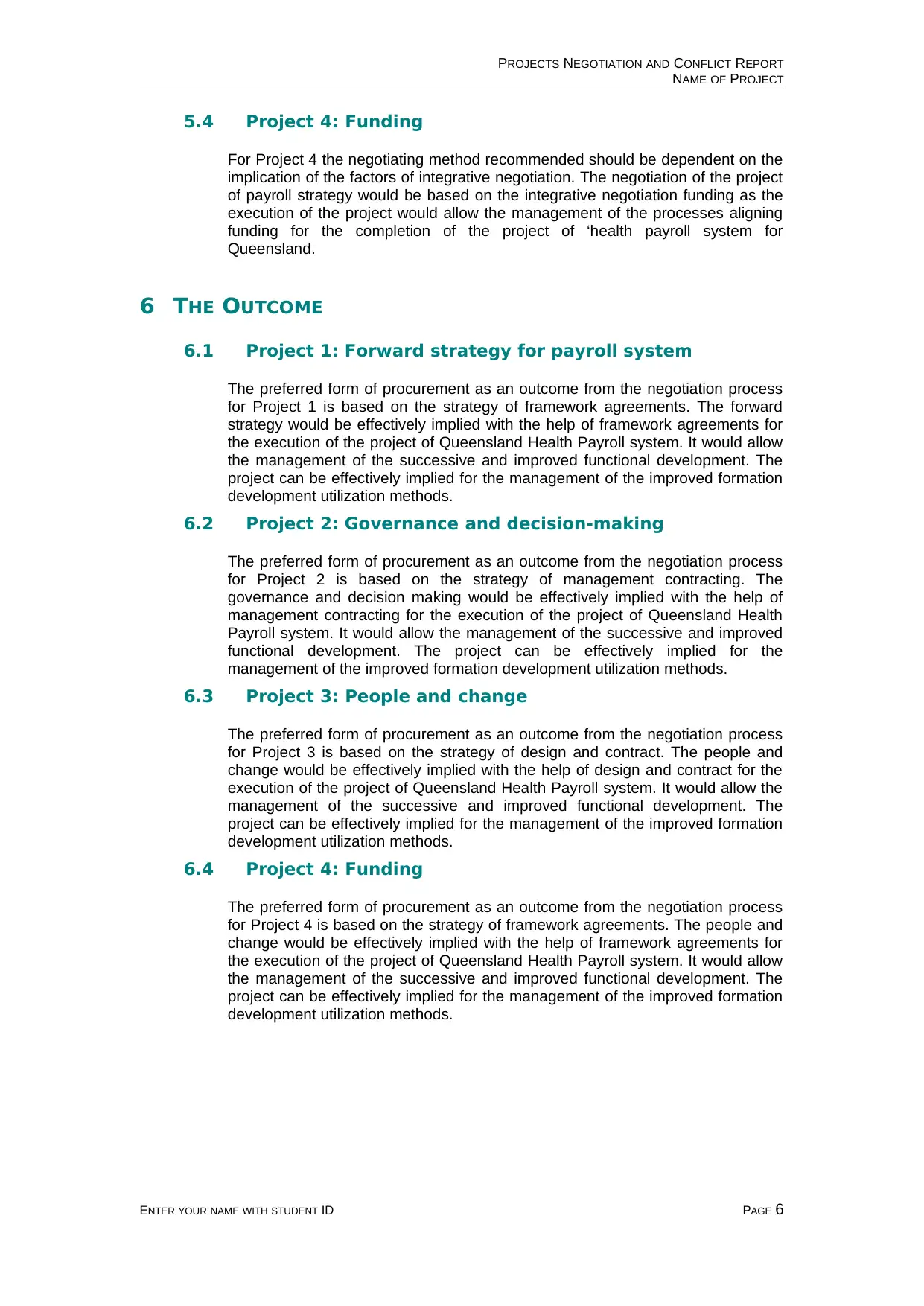
PROJECTS NEGOTIATION AND CONFLICT REPORT
NAME OF PROJECT
5.4 Project 4: Funding
For Project 4 the negotiating method recommended should be dependent on the
implication of the factors of integrative negotiation. The negotiation of the project
of payroll strategy would be based on the integrative negotiation funding as the
execution of the project would allow the management of the processes aligning
funding for the completion of the project of ‘health payroll system for
Queensland.
6 THE OUTCOME
6.1 Project 1: Forward strategy for payroll system
The preferred form of procurement as an outcome from the negotiation process
for Project 1 is based on the strategy of framework agreements. The forward
strategy would be effectively implied with the help of framework agreements for
the execution of the project of Queensland Health Payroll system. It would allow
the management of the successive and improved functional development. The
project can be effectively implied for the management of the improved formation
development utilization methods.
6.2 Project 2: Governance and decision-making
The preferred form of procurement as an outcome from the negotiation process
for Project 2 is based on the strategy of management contracting. The
governance and decision making would be effectively implied with the help of
management contracting for the execution of the project of Queensland Health
Payroll system. It would allow the management of the successive and improved
functional development. The project can be effectively implied for the
management of the improved formation development utilization methods.
6.3 Project 3: People and change
The preferred form of procurement as an outcome from the negotiation process
for Project 3 is based on the strategy of design and contract. The people and
change would be effectively implied with the help of design and contract for the
execution of the project of Queensland Health Payroll system. It would allow the
management of the successive and improved functional development. The
project can be effectively implied for the management of the improved formation
development utilization methods.
6.4 Project 4: Funding
The preferred form of procurement as an outcome from the negotiation process
for Project 4 is based on the strategy of framework agreements. The people and
change would be effectively implied with the help of framework agreements for
the execution of the project of Queensland Health Payroll system. It would allow
the management of the successive and improved functional development. The
project can be effectively implied for the management of the improved formation
development utilization methods.
ENTER YOUR NAME WITH STUDENT ID PAGE 6
NAME OF PROJECT
5.4 Project 4: Funding
For Project 4 the negotiating method recommended should be dependent on the
implication of the factors of integrative negotiation. The negotiation of the project
of payroll strategy would be based on the integrative negotiation funding as the
execution of the project would allow the management of the processes aligning
funding for the completion of the project of ‘health payroll system for
Queensland.
6 THE OUTCOME
6.1 Project 1: Forward strategy for payroll system
The preferred form of procurement as an outcome from the negotiation process
for Project 1 is based on the strategy of framework agreements. The forward
strategy would be effectively implied with the help of framework agreements for
the execution of the project of Queensland Health Payroll system. It would allow
the management of the successive and improved functional development. The
project can be effectively implied for the management of the improved formation
development utilization methods.
6.2 Project 2: Governance and decision-making
The preferred form of procurement as an outcome from the negotiation process
for Project 2 is based on the strategy of management contracting. The
governance and decision making would be effectively implied with the help of
management contracting for the execution of the project of Queensland Health
Payroll system. It would allow the management of the successive and improved
functional development. The project can be effectively implied for the
management of the improved formation development utilization methods.
6.3 Project 3: People and change
The preferred form of procurement as an outcome from the negotiation process
for Project 3 is based on the strategy of design and contract. The people and
change would be effectively implied with the help of design and contract for the
execution of the project of Queensland Health Payroll system. It would allow the
management of the successive and improved functional development. The
project can be effectively implied for the management of the improved formation
development utilization methods.
6.4 Project 4: Funding
The preferred form of procurement as an outcome from the negotiation process
for Project 4 is based on the strategy of framework agreements. The people and
change would be effectively implied with the help of framework agreements for
the execution of the project of Queensland Health Payroll system. It would allow
the management of the successive and improved functional development. The
project can be effectively implied for the management of the improved formation
development utilization methods.
ENTER YOUR NAME WITH STUDENT ID PAGE 6
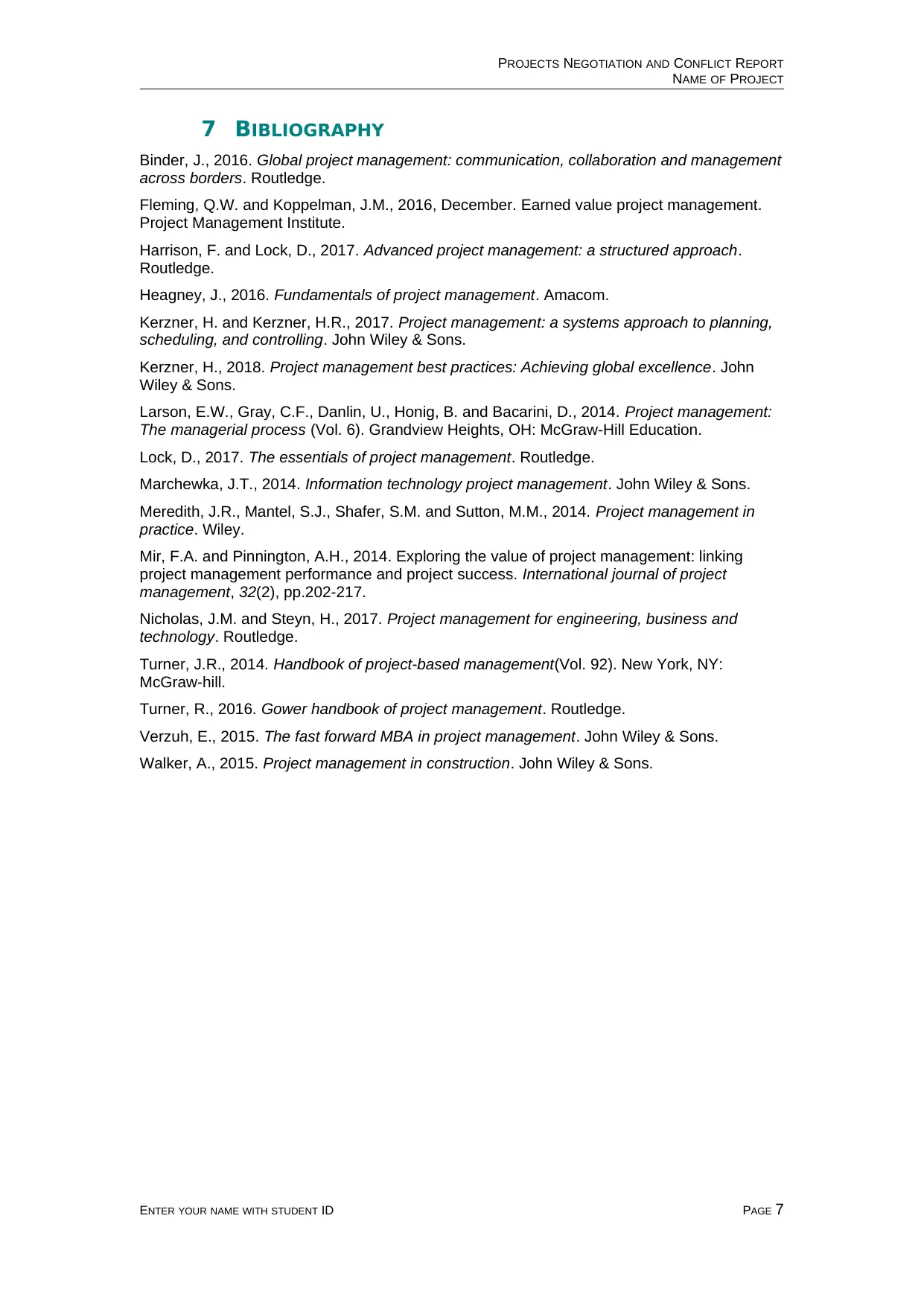
PROJECTS NEGOTIATION AND CONFLICT REPORT
NAME OF PROJECT
7 BIBLIOGRAPHY
Binder, J., 2016. Global project management: communication, collaboration and management
across borders. Routledge.
Fleming, Q.W. and Koppelman, J.M., 2016, December. Earned value project management.
Project Management Institute.
Harrison, F. and Lock, D., 2017. Advanced project management: a structured approach.
Routledge.
Heagney, J., 2016. Fundamentals of project management. Amacom.
Kerzner, H. and Kerzner, H.R., 2017. Project management: a systems approach to planning,
scheduling, and controlling. John Wiley & Sons.
Kerzner, H., 2018. Project management best practices: Achieving global excellence. John
Wiley & Sons.
Larson, E.W., Gray, C.F., Danlin, U., Honig, B. and Bacarini, D., 2014. Project management:
The managerial process (Vol. 6). Grandview Heights, OH: McGraw-Hill Education.
Lock, D., 2017. The essentials of project management. Routledge.
Marchewka, J.T., 2014. Information technology project management. John Wiley & Sons.
Meredith, J.R., Mantel, S.J., Shafer, S.M. and Sutton, M.M., 2014. Project management in
practice. Wiley.
Mir, F.A. and Pinnington, A.H., 2014. Exploring the value of project management: linking
project management performance and project success. International journal of project
management, 32(2), pp.202-217.
Nicholas, J.M. and Steyn, H., 2017. Project management for engineering, business and
technology. Routledge.
Turner, J.R., 2014. Handbook of project-based management(Vol. 92). New York, NY:
McGraw-hill.
Turner, R., 2016. Gower handbook of project management. Routledge.
Verzuh, E., 2015. The fast forward MBA in project management. John Wiley & Sons.
Walker, A., 2015. Project management in construction. John Wiley & Sons.
ENTER YOUR NAME WITH STUDENT ID PAGE 7
NAME OF PROJECT
7 BIBLIOGRAPHY
Binder, J., 2016. Global project management: communication, collaboration and management
across borders. Routledge.
Fleming, Q.W. and Koppelman, J.M., 2016, December. Earned value project management.
Project Management Institute.
Harrison, F. and Lock, D., 2017. Advanced project management: a structured approach.
Routledge.
Heagney, J., 2016. Fundamentals of project management. Amacom.
Kerzner, H. and Kerzner, H.R., 2017. Project management: a systems approach to planning,
scheduling, and controlling. John Wiley & Sons.
Kerzner, H., 2018. Project management best practices: Achieving global excellence. John
Wiley & Sons.
Larson, E.W., Gray, C.F., Danlin, U., Honig, B. and Bacarini, D., 2014. Project management:
The managerial process (Vol. 6). Grandview Heights, OH: McGraw-Hill Education.
Lock, D., 2017. The essentials of project management. Routledge.
Marchewka, J.T., 2014. Information technology project management. John Wiley & Sons.
Meredith, J.R., Mantel, S.J., Shafer, S.M. and Sutton, M.M., 2014. Project management in
practice. Wiley.
Mir, F.A. and Pinnington, A.H., 2014. Exploring the value of project management: linking
project management performance and project success. International journal of project
management, 32(2), pp.202-217.
Nicholas, J.M. and Steyn, H., 2017. Project management for engineering, business and
technology. Routledge.
Turner, J.R., 2014. Handbook of project-based management(Vol. 92). New York, NY:
McGraw-hill.
Turner, R., 2016. Gower handbook of project management. Routledge.
Verzuh, E., 2015. The fast forward MBA in project management. John Wiley & Sons.
Walker, A., 2015. Project management in construction. John Wiley & Sons.
ENTER YOUR NAME WITH STUDENT ID PAGE 7
1 out of 7
Related Documents
Your All-in-One AI-Powered Toolkit for Academic Success.
+13062052269
info@desklib.com
Available 24*7 on WhatsApp / Email
![[object Object]](/_next/static/media/star-bottom.7253800d.svg)
Unlock your academic potential
© 2024 | Zucol Services PVT LTD | All rights reserved.
